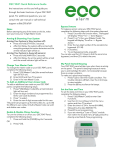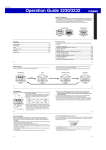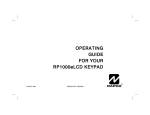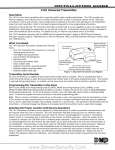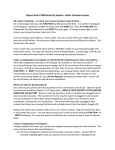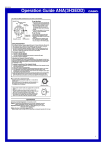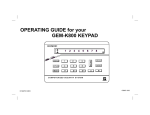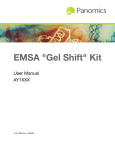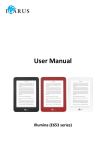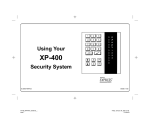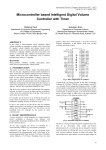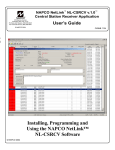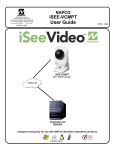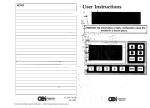Download RP1054D User Manual - Central Station Inc.
Transcript
OPERATING GUIDE FOR YOUR RP1054D KEYPAD © Napco 1992 DESIGN PATS. PENDING www.BevanSecurity.Com INTRODUCTION CONGRATULATIONS! ...on your purchase of a NAPCO Magnum Alert security system. Your new installation is a sophisticated warning system with many available features. Your alarm specialist will explain your system and show you how it works. Contact him should questions concerning operation arise. These instructions contain important information about the operation of your system with the RP1054D Keypad. Read them carefully and keep them handy for future reference. Check the Glossary for an explanation of terms that may be unfamiliar to you. You’ll probably find items mentioned here that do not apply to your system. Napco control panels have such a wide variety of features that few, if any, security systems will ever need them all. Your alarm professional has chosen appropriate features for your situ- REMEMBER: TO SHUT OFF AN ALARM WHILE ARMED, ENTER YOUR CODE! TABLE OF CONTENTS Section ation. Your system has been carefully designed and engineered to the highest industry standards. To assure optimum safety and security, familiarize yourself with this equipment. Periodically check its condition and state of readiness by testing it at least once a week in both the ac/battery and battery-only modes (ask your installer how to make these tests). Page CENTRAL-STATION MONITORING ........................................................................................ 3 FIRE SIGNAL*: _______________________ BURGLARY SIGNAL*: _________________ GLOSSARY.............................................................................................................................. 4 KEYPAD CONTROLS AND INDICATORS............................................................................... 6 HOLD-DOWN FUNCTIONS..................................................................................................... 7 SELECTING AND PROGRAMMING YOUR CODES............................................................... 8 SETTING THE ALARM (ARMING) WHEN LEAVING ............................................................... 9 EXIT DELAY: _________________________ ENTRY DELAY: ______________________ FOR SERVICE: _______________________ TURNING OFF THE ALARM (DISARMING) WHEN RETURNING......................................... 10 PROTECTING YOURSELF WHILE ON THE PREMISES...................................................... 11 FIRE PROTECTION ............................................................................................................... 12 2 www.BevanSecurity.Com CENTRAL STATION: __________________ *FIRE HAS PRIORITY OVER BURGLARY CENTRAL-STATION MONITORING Your alarm specialist may have programmed your system to be monitored by a central station. The built-in digital communicator can transmit emergency signals and status reports to the central station 24 hours a day. Your alarm specialist may have also programmed your system to automatically send a test signal to the central station every 24 hours. Central-Station Ringback (Programmed Option). The central station will acknowledge arming of the system by ringing back with a short beep from the keypad sounder. COMMUNICATOR FEATURES Abort Delay. Note which of your zones have abort delay, a delay that allows you time to reset the system, thus aborting a report to the central station. • Regular Burglary (Non-24-Hour) Zone reports are aborted by disarming within the delay period. • 24-Hour Zones and zones programmed to report restores must be repaired first, then the panel armed and disarmed, all within the delay period. Opening and Closing Reporting. Notifies the central station every time the system is disarmed and armed. Each user opening or closing can be identified by his code. Telephone-Line Test (Programmed Option). To check your telephone connection with the central station hold down Key [6]. After the beep sounds, a pulse tone will be heard from the keypad sounder. If the phone line is good the sound will silence in a few seconds. If not, a continuous tone will sound. The keypad sounder can be silenced by pressing Key [9]. 3 www.BevanSecurity.Com GLOSSARY Note: Not all features are applicable to all systems. Abort Delay. A delay period that allows the control panel to be reset, thereby aborting a report to a central station. Ambush Code. A 2-digit code entered when forced to disarm. Sends a silent alarm to the central station. Arm. To turn the system on by entering a User Code at the keypad. Arm/Disarm Code. A personalized code for arming and disarming the system. It may contain up to four digits. Battery. Backup power source in the controlpanel enclosure to provide protection for at least four hours in the event of a power failure. Bypass Button (Key [S] on keypad). Allows you to manually remove one or more protective zones from the system. Central Station. Monitors incoming reports and emergency messages from a digital communicator and notifies the proper authorities (optional). Chime. A keypad beep while disarmed alert- ing that the programmed zone (Entry Zone, in the MA854) has been opened. Chime Zones may have been programmed to display when activated (option in MA1008 and MA1010). Also see Never-Arm Zone. Closing. A report sent to the central station when the premises is closed (system armed) (optional). Communicator. Reports intrusions and emergencies directly to the central station over telephone lines. Control Panel. The brain of the system, it controls all system functions. Disarm. To turn the system off by entering a User Code at the keypad. Exit/Entry Delay. A programmed time that lets you exit and enter your premises without setting off an alarm after the system is armed. Instant Protection. Arming without entry delay while on the premises using Key [4]. Keypad. Puts control-panel functions at your fingertips. It can be mounted anywhere in your premises. Opening. A report sent to the central station 4 www.BevanSecurity.Com when the premises is opened (system disarmed) (optional). Panic Buttons (optional). Keys [ * ] and [# ] on the keypad, pressed at the same time to alert the central station of an emergency. Report. A transmission to a central station specifying a change in the status of the system (alarm, trouble, low battery, etc.) (optional). Ringback. A beep after arming verifying central-station receipt of report. Service Code. (MA1008 and MA1010 only): A restricted Arm/Disarm Code intended for temporary use. Sounder. A local warning device at the keypad to alert that (a) entry delay has started; (b) an attempt was made to arm with a zone in trouble; (c) Chime Zone or Day Zone activated; (d) a fire alarm or fire trouble condition exists; or (e) the central station has acknowledged arming (optional). GLOSSARY Trouble. An open door, window, or other problem on a zone that may prevent arming. User Program Code. A code (up to 6 digits) required to enter the Program Mode in order to program or change Arm/Disarm Codes. Watch Mode (MA1008 and MA1010 only). Turns all Day Zones on and off simultaneously by pressing Key [S] twice. (Optional.) Zones. Independent circuits that protect specific areas of the premises: • Auto-Bypass Zone: A zone that will automatically be bypassed from the system if in trouble (faulty) when the system is armed. (Not available in UL installations.) • Burglary Zone: Detects intrusion. • Day Zone: A zone programmed to cause visual and audible indication at the keypad when it is in trouble while disarmed. This feature is generally used to detect a problem, such as a break in a window foil, during the day. If a Day Zone is open, the green STATUS light will flash, the sounder will pulse, and the numerical display will indicate the zone. Hold down Key [9] to si- • • • • lence the sounder and clear the display. Arm and disarm the panel to re-enable the Day Zone. (In the MA1008 or MA1010, this feature may have been programmed so that Key [9] will turn off only the sounder; the display will continue to indicate the open zone until the zone is corrected, at which time the display will be cleared and the Day Zone re-enabled.) Exit/Entry Zone: Provides exit and entry delays to permit arming and disarming without causing an alarm. Exit/Entry Follower Zone: For interior zones. Ignores detection during exit delay; ignores detection during entry delay only if re-entry takes place through the normal exit/entry door. Fire Zone: A zone that provides audible and visual indication at the keypad in the event of a fire alarm or trouble condition. The Fire Zone is active 24 hours a day. Group-Bypass Zones: Circuits within the premises, usually including space-protection devices, interior doors, etc. (but not ex- terior doors or windows) that can all be bypassed simultaneously by pressing Key [S] twice. (Not available in UL installations.) • Never-Arm Zone: (MA1008 and MA1010 only): A zone that will remain disarmed, even when the rest of the system is armed. If Chime is programmed, the keypad will sound while armed or disarmed. This feature may be used as a driveway monitor, pool alert, etc. • Priority Zone: A zone that prevents arming if in trouble. • Priority Zone with Bypass: A Priority Zone that can be bypassed by pressing Reset Key [9] then entering your Arm/Disarm Code. • Selective-Bypass Zone: A zone that can be individually bypassed by pressing Key [S] followed by the zone number. • 24-Hour Zone: A zone that is armed and ready at all times to respond to an emergency situation. 5 www.BevanSecurity.Com KEYPAD CONTROLS AND INDICATORS Digital Display Flashes Number – indicates which non-24Hour Zones are in an alarm condition, and which Day Zones are in a trouble condition. Flashes “P” – indicates a priority condition (armed with a Priority Zone in trouble or armed without resetting a Day Zone). Displays one or more horizontal segments — STOP! Call for service. ARMED/ALARM Light On – system is armed. Flashing – alarm on a non-24-Hour Zone. Flashing (rapidly) – instant protection; entry delay cancelled. STATUS (Green) Light On – system disarmed, all non-24-Hour Zones okay. Flashing once every second – trouble on any non-24-Hour Zone. Flashing (rapidly) – trouble on Day Zone. BYPASS Light On (with red or green light on or flashing) – one or more zones manually bypassed. On (with no other lights but with or without a digit displayed) – STOP! Call for service. First Three Lights Flashing (slowly, with digit displayed (except with MA854 and early MA1008 & MA1010 panels)) – System trouble: see SETTING THE ALARM WHEN LEAVING. Flashing (rapidly, with pulsing sounder) – User Program Mode; press [S] twice to exit. zone in trouble. FIRE/TROUBLE Light On – Fire Zone in alarm condition. Flashing – Fire Zone in trouble condition. (To stop sounder “Trouble” warnings, hold down Key [9] for 2 seconds.) Keypad Sounder Steady Tone (with “P” displayed) – a priority condition exists. Steady Tone (when entering) – entry delay in progress. Beep (of programmed duration) – Chime Zone tripped. Beep (2 seconds) – system armed with a 6 www.BevanSecurity.Com Pulsing – Day Zone trouble; Fire Zone in trouble or in alarm. BYPASS BUTTON (Key [S]) To manually bypass a zone, press this button, then the digit representing the zone number. Refer to SETTING THE ALARM WHEN LEAVING: Arming With A Zone In Trouble. PANIC BUTTONS (KEYS [ * ] & [# ], Optional) Pressing these keys simultaneously will activate a Panic Alarm. See PROTECTING YOURSELF WHILE ON THE PREMISES. HOLD-DOWN FUNCTIONS To perform designated “Hold-Down” Functions, selected key must be held down for about 2 seconds, until sounder beeps. Note: Those functions identified by an asterisk (* ) have secondary utility functions for installer’s use only. Do not attempt to access these functions within 10 seconds after disarming. Key [1]: TEST Momentarily sounds the burglar alarm. If no alarm is heard, or if it is weak, the battery may need replacing. Make this test weekly. (To perform this function, hold down Key [1] until alarm sounds.) Key [2]: DISPLAY BYPASS Numerically displays all zones that have been bypassed using Key [S]. To perform this function, hold down Key [2] until the sounder beeps, and continue to hold it down until all zones have been displayed. Key [3]: DISPLAY STATUS Numerically displays all zones that are in “trouble”. To perform this function, hold down Key [3] until the sounder beeps, and continue to hold it down until all zones have been displayed. Key [4]: INSTANT PROTECTION* Cancels entry delay period when arming. The delay is restored after you disarm the system. To perform this function, hold down Key [4] until the sounder beeps. Key [5]: CHIME* (Chime Zone(s): _________) This will enable a feature that sounds a “chime” (beep) at the keypad each time a programmed zone (Entry Zone, in the MA854) is opened. The Chime Mode functions when the alarm system is disarmed (off), but it will always operate on a Never-Arm Zone (see GLOSSARY). To disable the chime feature, hold down Key [5] again (until sounder beeps). Key [6]: TELCO TEST* (Optional; Enabled? YES NO) Pressing the key tests your phone lines (the sounder will start to pulse). If the line is good, the pulsing will stop: if not, a steady tone will sound. (To perform this function, hold down Key [6] until sounder beeps.) Reset the sounder using Key [9]. Call for service, if necessary. Key [7]: FAULT FIND For installer’s use only; holding down Reset Key [9] or arming the panel will cancel the Fault-Find Mode. Key [8]: PROGRAM (Alarm functions are disabled while in the Program Mode.) Allows you to enter the Program Mode, where you can program up to 5 personal User Codes (up to 4 in the MA854), including a Service Code (MA1008 and MA1010 only, optional). Refer to SELECTING AND PROGRAMMING YOUR CODES for more information. (To perform this function, hold down Key [8] until sounder beeps.) Key [9]: RESET Resets any sounder indication, systemtrouble indication, Day-Zone indication (in MA1008 and MA1010, may be programmed to reset Day-Zone condition), and Fault-Find Mode. After an alarm occurs and the system is disarmed, the numerical display will still indicate which non-24-Hour Zone(s) caused the alarm. Key [9] will clear the display. (To perform this function, hold down Key [9] until sounder beeps.) Key [S]: ALARM HISTORY This will flash the red ARMED/ALARM light to indicate the last alarm condition. The numerical display will indicate the zones violated. History is not lost when the system is rearmed; the previous alarm history will remain in alarm memory until automatically reset by a new alarm condition. To perform this function, hold down Key [S] until the sounder beeps, then continue to hold it down until all information has been displayed. 7 www.BevanSecurity.Com SELECTING AND PROGRAMMING YOUR CODES Note: While programming, fire/burglar alarm functions are disabled. User (Arm/Disarm) Codes You can choose up to 5 different four-digit codes (4 in the MA854) that will allow you to arm and disarm your system. Any of these codes can easily be changed or removed should it become necessary in the future to deny a user access to the premises. Your security system cannot be disarmed by unauthorized persons. It will respond only when a code of your choosing is entered through the keypad. Service Code (MA1008 and MA1010 only) Your alarm specialist may have programmed User 5’s code as a Service Code, a temporary code intended for occasional use only, thus allowing guests, babysitters, service employees, etc. limited access to the control panel. When no longer needed, the code is disabled. The Service Code is controlled by User 1. Whenever User 1’s Code is entered, the Serv- ice Code is disabled, and it remains disabled until the panel is once again armed using the Service Code. (The Service Code can always be used to arm and, in fact, can be programmed as an arm-only code by your installer.) Selecting Your Codes After your alarm specialist installs your system, he will give you a “User Program Code” and show you how to program your User Codes. For optimum security, do not select obvious combinations, such as consecutive numbers (1,2,3,4), repetitive numbers (2,2,2,2), your street or telephone number, birth date, etc., for any user code. A code of at least three digits is required in UL installations. 1. Hold down Key [8] until the sounder beeps. This puts the system into the User Program Mode. 2. Enter your Program Code into the keypad; the first three lights will flash and sounder will pulse. Program your User Codes as follows: 8 www.BevanSecurity.Com a. Press Key [S]. b. Enter the user number “1” through “5” (“1” through “4” in the MA854). (MA1008, MA1010: Enter “5” for the Service Code, if available.) c. Enter a code of up to four-digits (digits 19 only). Examples: Press • [S] + [1] + up to four digits = User 1’s Code • [S] + [2] + up to four digits = User 2’s Code • [S] + [5] + up to four digits = User 5’s Code (or Service Code) You do not have to assign all codes. Use as many as you need and change them as necessary. To erase any code(s), repeat steps 1, 2a, and 2b. For example, to erase User 3, enter [S] + [3] (do not enter the four-digit code). 3. To end the programming mode, press Key [S] twice. SETTING THE ALARM (ARMING) WHEN LEAVING Arming Before You Leave Check the green STATUS light on the keypad. If it is on, enter your code. The red ARMED/ALARM light will come on and the green light will go off. If your system was programmed for an automatic audible test on arming, the alarm will sound briefly shortly after arming. Note: It is possible to arm your system with a bad or disconnected battery. Leave immediately through the exit/entry door before your exit delay time runs out. If you wait too long, the keypad sounder will warn that your exit delay time has elapsed and entry delay has started. To avoid causing an alarm, quickly return to the keypad and enter your code to reset the control panel. You may then arm the system again. Arming With A Zone In Trouble A flashing green STATUS light indicates that at least one zone is “in trouble”, that is, the zone is not secured. If a Day Zone is in trouble, the zone will also display numerically and the sounder will be pulsing. Any zone in trouble may be displayed by holding down Key [3] until the sounder beeps. Try to fix the zone by closing windows or doors that may be open. If a Day Zone is in trouble, reset the Day-Zone indication by arming and disarming or, if so programmed, by holding down Key [9] until the sounder beeps. (Reset the Day manually bypassed simultaneously by simply pressing Key [S] twice See PROTECTING YOURSELF WHILE ON THE PREMISES: Bypassing Interior Zones. You will not be able to arm your system if (a) a Priority Zone is in trouble; (b) a Day-Zone numerical display is still flashing; or (c) the first three keypad lights are flashing due to a system trouble. If you attempt to arm, the sounder will come on and a “P” will be displayed. Enter your code again, and reset the keypad indication by holding down Key [9] (remember to test your system!). The “P” must be cleared by fixing or bypassing the zone in trouble. Priority Zones must be corrected before the system can be armed. Zones selected for Priority with Bypass may be bypassed by holding down Reset Key [9] before arming. Be sure to have all zones in trouble fixed quickly. Zone by correcting the condition, then arming and disarming.) If no zones are in trouble, the green light will come on, indicating that the system is ready to be armed. If a zone cannot be fixed immediately, you may still be able to arm without the protection of that zone. Check your Alarm Plan (see control-panel instructions). If Auto-Bypass was programmed for the zone in trouble (not for UL installations), simply arm your system. A short beep will sound at the keypad, indicating that a zone has been auto-bypassed, that is, it has been removed from the system and cannot cause an alarm. If the zone is programmed for Selective Bypass, pressing Key [S] and then the number of the zone will manually bypass that zone. (Caution: Temporary users should never be shown how to bypass a zone.) Group-Bypass Zones are a group of zones that can all be SYSTEM TROUBLES Check your keypad before you attempt to arm. A number flashing together with the ARMED/ALARM, STATUS, and BYPASS lights will alert you of a problem in the system, as indicated below. If you must arm in this condition, hold down Key [9] until the function beep sounds to temporarily reset the keypad, then test the system by holding down Key [1]. If the alarm sounds, arm the system, however be sure to have the problem corrected as soon as possible. If the alarm does not sound or is weak call your alarm specialist. TEST YOUR SYSTEM WEEKLY! • “ 1” (Power Failure). Check for an area power outage. Also check that the panel’s power transformer is plugged in. • “ 2” (Low Battery). Hold down Key [9] to clear the display, then hold down Key [1] to intiate a Bell/Battery Test. If the low-battery display returns, the battery may need replacement. Call for service. Note: If arming with a low-battery indication (not in all models), backup power may not be present in the event of a power failure. • “ 3” (Failure to Communicate). (Displayed with steady sounder.) Hold down Key [9] to reset the keypad, then hold down Key [6] to test the phone lines. If the indication returns, call for service. (A successful communication will clear the system trouble display. • ANY OTHER NUMBER — Call your alarm professional. 9 www.BevanSecurity.Com TURNING OFF THE ALARM (DISARMING) WHEN RETURNING Disarming When You Return When you enter through the exit/entry door, the sounder will come on for the entire entry period. (If, upon entering, the red ARMED/ALARM light is flashing, leave the premises and call authorities from a neighbor’s telephone.) Disarm the panel quickly using your Arm/Disarm Code. Note: If you enter the wrong code, you must wait at least 2 seconds before trying again. If there has been an alarm on a non-24-Hour Zone, the ARMED/ALARM light will be flashing and the zone number will be displayed, even after you disarm. To reset the display, hold down Key [9]. When the system is disarmed, the red ARMED/ALARM light will go off and the green light will come on (or flash if a zone is in trouble). If an alarm occurred on a 24-Hour Zone, there will be no indication at the keypad, however an alarm condition will be recorded by 10 www.BevanSecurity.Com Alarm History (see Key [ S] : Bypass/Alarm History). Ambush Code If an intruder forces you to disarm your system, enter your programmed one- or two-digit Ambush Code before your Arm/Disarm Code. This activates the Ambush feature, which will send a silent alarm to a central station. (Ambush is an optional feature.) PROTECTING YOURSELF WHILE ON THE PREMISES Arming With Zones Bypassed Your alarm specialist may have programmed one or more zones for Selective Bypass, that is, they may be removable from the system. Since a bypassed zone cannot cause an alarm, you may wish to use this feature to turn off the interior areas while armed and keep your perimeter zones (windows, doors, etc.) active. Press the bypass button (Key [S]), then the number of the zone you wish to bypass. Check the green STATUS light to be sure that no zone is in trouble, then enter your arming code to arm. To verify which zones have been bypassed, hold down Key [2] until all zones have been displayed. Bypassing Interior Zones Your installer may have also selected all interior zones to be Group Bypass Zones (not for UL installations). Bypass these zones all at the same time by simply pressing Key [S] twice. The yellow BYPASS light will come on whenever you bypass one or more zones. Enter your code to arm remaining zones; the green light will go off and the red ARMED/ALARM light will come on. The yellow light will go off the next time you disarm, indicating that the bypassed zones are no longer bypassed. (The BYPASS light does not come on when zones are auto-bypassed (unless programmed otherwise by your alarm specialist.) To review which zones have been bypassed, hold down Key [2] until all bypassed zones have been displayed. Arming With Instant Protection Holding down Key [4] (until beep sounds) will cancel the entry delay on the exit/entry zones when arming. The red ARMED/ALARM light will flash rapidly to indicate this condition. If someone enters through an Exit/Entry Zone, an alarm will sound immediately. Panic Alarm (Keypad Panic Disabled? YES NO) To activate a Panic Alarm, press Keys [ * ] and [# ] at the same time. This feature may have been programmed to send a silent alarm to a central station, activate an audible alarm, or both. 11 www.BevanSecurity.Com FIRE PROTECTION The following information is applicable only where local ordinance permits use of your alarm control panel for fire detection. Refer to the instructions furnished with the control panel for important information on how to prepare an evacuation plan. Controlling Your Fire Circuit If your system includes smoke detectors or heat-sensing thermostats, you have 24-hour fire protection. The panel will constantly monitor this zone for any alarm or trouble condition. Fire-Zone Alarm An alarm on the Fire Zone will cause the red FIRE/TROUBLE light to come on and the sounder to pulse. The fire alarm will sound, overriding any other alarm. Fire-Zone Trouble If there is trouble on the fire circuit, the red FIRE/TROUBLE light will flash and the sounder will pulse after a 10-second delay. To silence the sounder, hold down Key [9]. The light will continue to flash to indicate the trouble. After the trouble is repaired, hold down Key [9] again until the beep sounds; the keypad will reset after a brief delay and the light will go off. down Key [9] for 2 seconds, then arming and disarming or (if so programmed) by waiting for it to automatically shut off. The sounder and the FIRE/TROUBLE light will stay on. Hold down Key [9] to silence the sounder. The red FIRE/TROUBLE light should go off in about 30 seconds. If smoke has not cleared from a smoke detector, or a thermostat has not cooled, the red FIRE/TROUBLE light will remain on. Hold down Key [9] every 30 seconds or so until the condition has cleared and the light goes off. Resetting After An Alarm The fire alarm may be reset by holding Napco Security Systems, Inc. 333 Bayview Avenue Amityville, New York 11701 OI142B 7/93 www.BevanSecurity.Com












